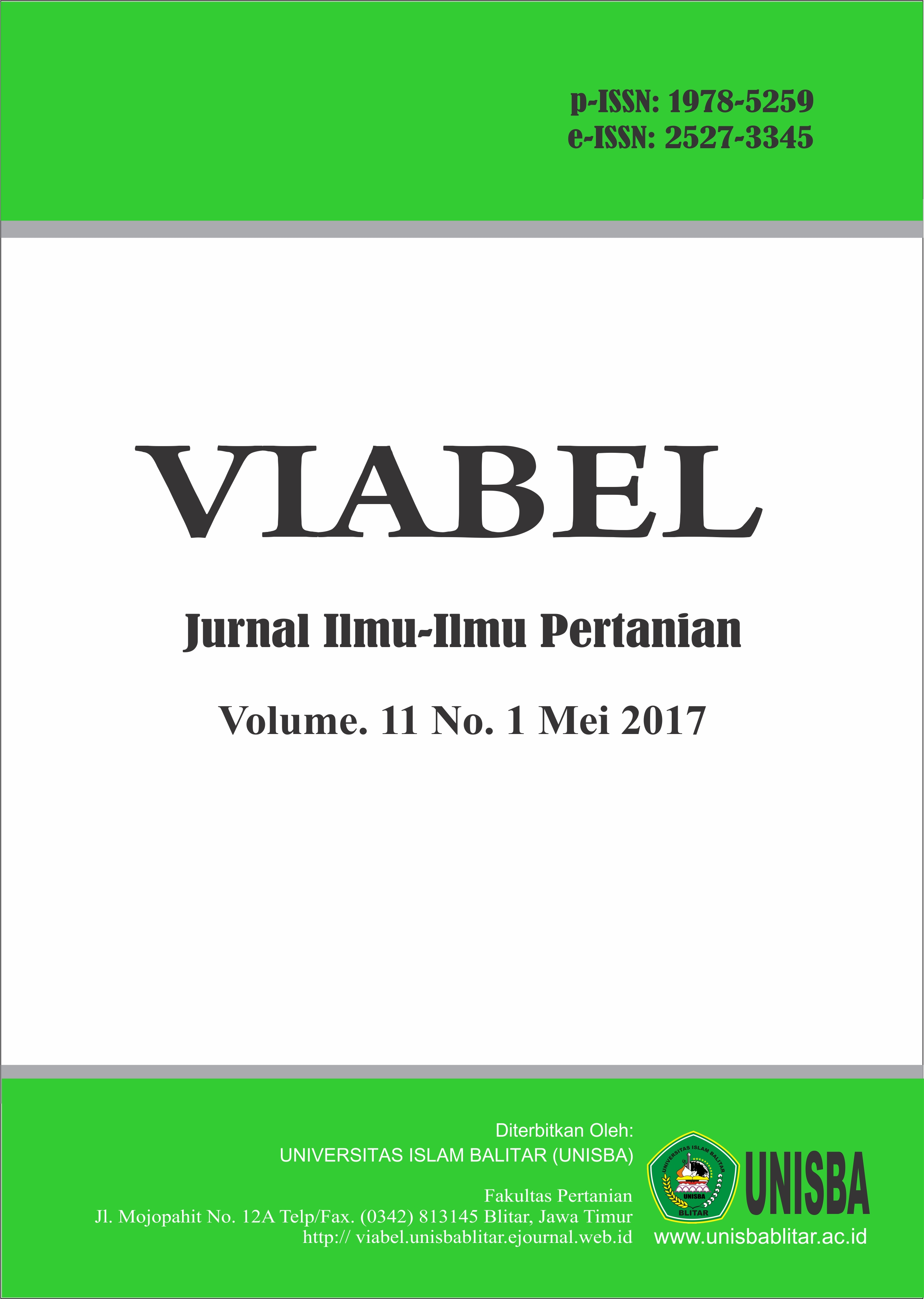PENGARUH DOSIS PUPUK FOSFOR DAN KONSENTRASI GIBERELIN PADA PERTUMBUHAN DAN HASIL TANAMAN KUBIS BUNGA (Brassica oleraceea L.)
DOI:
https://doi.org/10.35457/viabel.v11i2.265Keywords:
Flower Cabbage, Phosphorus, and GiberelinAbstract
The flower cabbage (Brassica oleraceea L.) is a type of vegetable plant belonging to the family of cabbage plants (Cruciferae). Flower cabbage often called "cauliflower" has many benefits to consume, because it contains calories, protein, carbohydrates, calcium, and vitamins A, B1 and C. Farming is very much affected by the state of agricultural land, a problem that often occurs due to lack of elemental content nutrients in the soil that affect the inflorescence and flower cabbage growth. Therefore, to increase the yield of cabbage flowers offered the method of land optimization with the addition of nutrients in the form of phosphorous soil and also the addition of gibberellin hormone that has a role to flowering cabbage plants. The research was conducted by using Randomized Block Design (RBD) in divided plots with 2 treatments, Phosphorus (P) as the main plot with 3 treatment levels P1 (100 kg / ha), P2 (125 kg / ha) and P3 150 kg/ha then the concentration of Giberelin (K) as a subplot with 3 levels of treatment K1 (75 mg / L), K2 (100 mg / L) and K3 (125 mg / L)). From the result of the combination of the two treatments were 9 treatment combinations, repeated 3 times to obtain 27 units combination of treatments, each experimental plot consisted of 15 plants. Parameters observed include plant height, number of leaves, number of flowering plants, flower diameter and flower weight. The result of the research showed no significant interaction in all plant variables but the dosage of phosphorus fertilizer gave significant effect on the height variable of the 10 hst plant on the P1 (100 kg/ha) treatment, the leaf number variant showed significant effect at age 40 hst on P3 treatment (150 kg / ha), the number of flowering plant variables showed significant effect of 60 hst on P3 treatment (150 kg / ha), flower diameter variables showed significant differences in P3 treatment (150 kg / ha). The best treatment is P3 treatment (150 kg / ha). Gibberellin concentrations did not have a real effect on all plant variants.Downloads
References
Barus, Wan Arfani dkk. 2013. respon pertumbuhhan dan produksi kacang hijau akibat pemberian pupuk organik cair dan pupuk tsp. Agrium Vol. 19 (1) : 1-11
Cahyono, B. 2001. Kubis Bunga dan Broccoli. Kanisius. Yogyakarta
Fei L, el all 2011. Effects of phosphorus accumulation in soil with the utilization ages of the vegetable greenhouses in the suburb of Shenyang. Procedia Environmental Sciences 8:16-20. DOI: 10.1016/j.proenv.2011.10.005.
Hanum, Chairani. Teknik Budidaya Tanaman Jilid 3 untuk SMK. Jakarta. Direktorat Pembinaan Sekolah Menengah Kejuruan, Direktorat Jenderal Manajemen Pendidikan Dasar dan Menengah, Departemen Pendidikan Nasional, 2008.
Mayun, I.A, 2007. Efek Mulasa Jerami Padi dan Pupuk Kandang Sapi Terhadap Pertumbuhan dan Hasil Bawang Merah Didaerah Pesisir. Agritrop, 26 (1) : 33-40.
Rudi dan Tri Harjon. 2012. Karakter hasil biji kacang hijau pada kondisi pemupukan P dan insensitas peyiangan yang berbeda. Jurnalagrivor 11 (2) :137-143
Rukmana, R. 1994. Budidaya Kubis Bunga dan Broccoli. Kanisius, Yogyakarta. 64 hlm.di dalam Ainun Marliah et al. (2013)
Wang Y, Zhang Y. 2008. Soil-phosphorus distribution and availability as affected by subsurface irrigation. J Plant Nnutr Soil Sci. 173:345-352. DOI : 10.1002/jpln.200800284.
Downloads
Published
Issue
Section
License
Copyright (c) 2017 VIABEL: Jurnal Ilmiah Ilmu-Ilmu Pertanian

This work is licensed under a Creative Commons Attribution-ShareAlike 4.0 International License.
Authors who publish with this journal agree to the following terms:
- Copyright on any article is retained by the author(s).
- The author grants the journal, right of first publication with the work simultaneously licensed under a Creative Commons Attribution License that allows others to share the work with an acknowledgment of the work’s authorship and initial publication in this journal.
- Authors are able to enter into separate, additional contractual arrangements for the non-exclusive distribution of the journal’s published version of the work (e.g., post it to an institutional repository or publish it in a book), with an acknowledgment of its initial publication in this journal.
- Authors are permitted and encouraged to post their work online (e.g., in institutional repositories or on their website) prior to and during the submission process, as it can lead to productive exchanges, as well as earlier and greater citation of published work.
- The article and any associated published material is distributed under the Creative Commons Attribution-ShareAlike 4.0 International License










.png)




